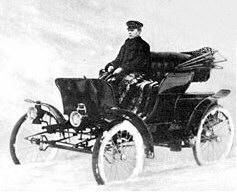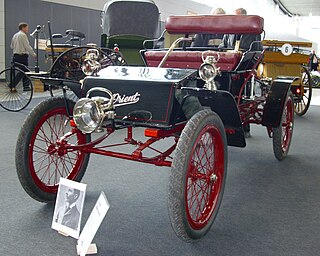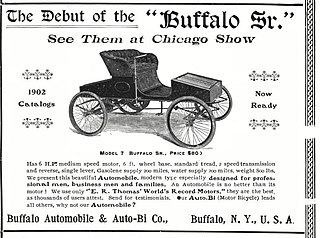Related Research Articles

Ransom Eli Olds was a pioneer of the American automotive industry, after whom the Oldsmobile and REO brands were named. He claimed to have built his first steam car as early as 1887 and his first gasoline-powered car in 1896. The modern assembly line and its basic concept is credited to Olds, who used it to build the first mass-produced automobile, the Oldsmobile Curved Dash, beginning in 1901.

Metro-Cammell, formally the Metropolitan Cammell Carriage and Wagon Company (MCCW), was an English manufacturer of railway carriages, locomotives and railway wagons, based in Saltley, and subsequently Washwood Heath, in Birmingham. Purchased by GEC Alsthom in May 1989, the Washwood Heath factory was closed in 2005.
Brush Traction is a manufacturer and maintainer of railway locomotives in Loughborough, England. It is a subsidiary of Wabtec.

A runabout is a car body style popular in the 1910s, based on the horse-drawn runabout carriage.

In automotive use, the Stanhope is a car body style characterized by its single bench seat mounted at the center, folding cloth top, and a dashboard at the front. These vehicles were built from approximately 1900 to 1910. The design was derived from the Stanhope horse-drawn carriage and could be considered a specific type of runabout.

Baker Motor Vehicle Company was an American manufacturer of Brass Era electric automobiles in Cleveland, Ohio, from 1899 to 1914.

Waltham Manufacturing Company (WMC) was a manufacturer of bicycles, motorcycles, motorized tricycles and quadricycles, buckboards, and automobiles in Waltham, Massachusetts. It sold products under the brand names Orient, Waltham, and Waltham-Orient. The company was founded in 1893, moving to self-propelled vehicles after 1898.

Pope-Waverley was one of the marques of the Pope Motor Car Company founded by Albert Augustus Pope and was a manufacturer of Brass Era electric automobiles in Indianapolis, Indiana. From 1908 until production ceased in 1914 they became independent again as the Waverley Company.

St. Louis Motor Carriage Company was a manufacturer of automobiles at 1211–13 North Vandeventer Avenue in St. Louis, Missouri, founded by George Preston Dorris and John L. French in 1898, with French taking charge of marketing and Dorris heading engineering and production. St. Louis Motor Carriage was the first of many St. Louis automakers and produced automobiles from 1899 to 1907.

Woods Motor Vehicle Company was an American manufacturer of electric automobiles in Chicago, Illinois, between 1899 and 1916. In 1915 they produced the Dual Power with both electric and internal combustion engines which continued until 1918.

Electric Vehicle Company was an American automobile holding company and early pioneering manufacturer of automobiles.
Columbia was an American brand of automobiles produced by a group of companies in the United States. They included the Pope Manufacturing Company of Hartford, Connecticut, the Electric Vehicle Company, and an entity of brief existence in 1899, the Columbia Automobile Company.
The Van Wagoner was an American electric automobile manufactured between 1899 and 1903 in Syracuse, New York, by the Syracuse Automobile Company. It was advertised as "built on a simple plan that does away with several levers and push buttons" and could purportedly be "controlled with one hand."

The Buffalo was an American automobile manufactured from 1900 until 1902, by the Buffalo Automobile and Auto-Bi Company of Buffalo, New York.

The Riker was a veteran and brass era electric car founded in 1898 in Elizabeth, New Jersey. Designed by Andrew L. Riker, they were built in small numbers until the company was absorbed by the Electric Vehicle Company in 1901.

The Mobile Company of America was an American steam automobile manufacturer founded in 1899 by John Brisben Walker with production in Tarrytown, New York.

Bolton Corporation Tramways operated a tramway service in Bolton between 1899 and 1947.

Frank Fowler Loomis was a nineteenth-century American businessman, blacksmith, fireman, engineer and electrician. He was a key manager and director in improving and developing the fire and police departments for the city of Akron, Ohio. Loomis was known for innovating new state of the art electrical-mechanical devices. He developed new style police and fire alarm systems for Akron. He designed and developed the world's first motorized police patrol wagon. This vehicle was an exhibit in the 1915 Panama–Pacific International Exposition. His electrical innovations and inventions were duplicated and put into use by other major cities in the United States. He established the "Loomis Award" for fire service valor and heroism.

William Morrison was a Scottish chemist. His background in chemistry piqued his interest in improving storage batteries. He concentrated on how to produce the most available energy for a unit of weight for efficiency in the working of an individual battery cell. Eventually, he developed storage batteries far more powerful than what had then been available. To demonstrate his batteries, Morrison installed 24 of them on a common horse-drawn carriage and attached an electric motor to the rear axle to be powered by them. Through various innovations, he developed the controls for the power used and the vehicle's steering so that the driver had complete control. Morrison invented the first practical self-powered four-wheeled electric carriage in the United States. His electric vehicle was the first to be driven in Chicago and in his hometown of Des Moines, Iowa. This electric horseless buggy of the late 19th century helped pave the way for the hybrid electric automobile of the 21st century.
References
- 1 2 3 Kimes, Beverly Rae; Clark Jr., Henry Austin (1996). Standard Catalog of American Cars 1805-1942 (3rd ed.). Krause Publications. ISBN 978-0-87341-428-9.